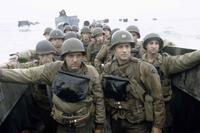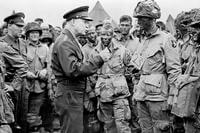"The Dirty Dozen" had everything anyone could hope for in a war movie. Convicts, trained as commandos and portrayed by Hollywood's best tough guys of the time, are dropped into Normandy on a suicide mission. Their aim is to kill the Nazi officers responsible for coordinating the German defense of France during a massive upcoming Allied amphibious invasion that would become known as "D-Day." If the commandos survive, they get a full pardon.
Critics and audiences alike loved it. Starring Lee Marvin, Charles Bronson and John Cassavetes, "The Dirty Dozen" became one of the fastest-grossing movies of all time, meaning people couldn't get their tickets for the movie fast enough -- although those numbers have been dwarfed in recent decades. The only real criticism of the movie was its wanton violence (which has also been dwarfed in recent years).
But Americans loved the story of the Dirty Dozen not just because of its on-screen adaptation, but because they first fell in love with the real-life inspiration for the movie: "The Filthy Thirteen."
Hollywood, of course, embellishes facts for dramatic effect, and "The Dirty Dozen" is no different. While the soldiers in the movie are presented as convicted murderers and thieves, the real Filthy Thirteen were just your average American soldiers who developed a healthy disregard for the rules -- although that's not where their nickname originates.
"We weren't murderers or anything," Filthy Thirteen veteran Jack Agnew once recalled. "We just didn't do everything we were supposed to do in some ways and did a whole lot more than they wanted us to do in other ways. We were always in trouble."
Officially designated as the 1st Demolition Section of the Regimental Headquarters Company of the 506th Parachute Infantry Regiment (PIR), 101st Airborne Division, the Filthy Thirteen earned the name while training in England. Instead of using their daily water rations to bathe and shave, they instead used it to cook wild game poached from the manor house next to their training area. It didn't help that they were also "the most difficult, insubordinate, and undisciplined individuals in the U.S. Army while in garrison," as a 2022 article in the U.S. military's NCO Journal described them.
"We never took care of our barracks or any other thing, or sanitation, and we were always restricted to camp," recalled the unit's leader, Jake "McNasty" McNiece. "But we went AWOL every weekend that we wanted to and we stayed as long as we wanted till we returned back, because we knew they needed us badly for combat. And it would just be a few days in the brig. We stole jeeps. We stole trains. We blew up barracks. We blew down trees. We stole the colonel's whiskey and things like that."
The Filthy Thirteen were dropped into Normandy on June 6, 1944, with the mission of destroying bridges over the Douve River to protect the assault forces' move inland from Utah Beach. When the day came, they dropped with the 3rd Battalion, 506th PIR, but half of the 13 were killed, captured or wounded during the jump, including their officer, Lt. Charles Mellen. What was left was led by McNiece, then a private, whose American Indian heritage inspired the men to cut their hair in a "mohawk" homage before making the jump.
The Army Air Forces, assuming the demolition team was dead, bombed the bridges anyway. The Filthy Thirteen then went on collecting stragglers and aided with the capture of the key French town of Carentan. But that wasn't the end of their role in World War II Europe. They would jump into occupied Holland during Operation Market Garden, where their mission was to secure three bridges near Eindhoven. They were split up after that.
Fearing Market Garden might be their last combat jump, some of the Filthy Thirteen joined the Pathfinders, specialized units that set up drop zones in occupied or disputed territory for resupply missions. McNiece and others found themselves being dropped in on a Pathfinder mission during the Battle of Bastogne.

Although there were 13 original members, with alternates and replacements, there were more than 13 members of the unit by the end of the war. The nickname caught the public's imagination after Stars and Stripes reporter Tom Hoge wrote about them in a June 1944 issue. Newspapers back home began repeating the nickname, and it eventually stuck.
From there, legends about the Filthy Thirteen, mostly rumors, began to spread into mainstream media. Some of those legends formed the basis of author E.M. Nathanson's book, "The Dirty Dozen," which became the movie loved by so many film buffs.
Just how much of "The Dirty Dozen" is real can only be known by the Filthy Thirteen. Agnew's daughter Barbara claims her father said it was about 30% -- which is still a lot.
"Dad, when we were little kids, he'd always say, 'I won the war; I know you don't believe me, but someday you'll know,'" she said.
Keep Up With the Best in Military Entertainment
Whether you're looking for news and entertainment, thinking of joining the military or keeping up with military life and benefits, Military.com has you covered. Subscribe to the Military.com newsletter to have military news, updates and resources delivered straight to your inbox.



























